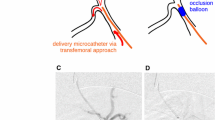Abstract
To develop a new technique for ablating arrhythmias by interruptingcoronary perfusion of the myocardium, we studied six mongrel dogs, weighing20–35 kg. Under angiographic guidance a microcatheter (1.0 mmdiameter) was introduced into a branch of the left anterior descending orposterior descending coronary artery. A detachable platinum coil (0.0254 cmdiameter, 3 cm length) soldered onto a stainless-steel delivery wire(Guglielmi) was inserted through the microcatheter and advanced to occludethe arterial branch. A 0.5-mA electric current applied to the proximal endof the delivery wire resulted in intravascular thrombosis due to attractionof the negatively charged blood cells, platelets, and fibrinogen to thepositively charged platinum coil. In approximately 4.5 minutes, as thethrombus was formed, electric current dissolved the soldering and detachedthe platinum coil from the delivery wire. Electrocardiograms showed focalST-T changes but no ventricular tachyarrhythmias. Pathologic studiesrevealed thrombosis around the platinum coil and well-demarcated focalischemia/infarction that was correlated with elevation of cardiac enzymes.We conclude that intracoronary arterial embolization and electrothrombosisusing an electrolytic platinum coil can be selectively performed in a verysmall coronary arterial branch, resulting in a limited area of myocardialdamage. This technique is potentially useful for ablating arrhythmias andmay be safer and more controllable than intracoronary alcohol infusion..
Similar content being viewed by others
References
Kowey PR, Podrid PJ. Sudden cardiac death: Evaluation and management. In: Podrid PJ, Kowey PR, eds. Cardiac Arrhythmia: Mechanism, Diagnosis, and Management. Baltimore, MD: Williams and Wilkins, 1995:964–1003.
The ESVEM Investigator. Electrophysiologic Study Versus Electrocardiographic Monitoring (ESVEM trial) for selection of antiarrhythmic therapy of ventricular tachyarrhythmias. Circulation 1989;79:1354–1360.
Mason JW. A comparison of seven antiarrhythmic drugs in patients with ventricular tachyarrhythmias. N Engl J Med 1993;329:452–458.
Harken AH, Josephson ME. Surgical management of ventricular tachycardia. In: Josephson ME, Wellens HJJ, eds. Tachycardias: Mechanisms, Diagnosis, and Treatment. Philadelphia: Lea and Febiger, 1984:475–487.
Mirowski M, Reid PR, et al. Clinical treatment of life-threatening ventricular tachyarrhythmias with the automatic implantable defibrillator. Am Heart J 1981;02:265–270.
Hartzler GO. Electrode catheter ablation of refractory focal ventricular tachycardia. J Am Coll Cardiol 1983;2:1107–1113.
Morady F, Harvey M, Kalbfleisch SJ, et al. Radiofrequency catheter ablation of ventricular tachycardia in patients with coronary artery disease. Circulation 1993;87:363–372.
Brugada P, de Swart H, Smeets JLRM, Wellens HJJ. Transcoronary chemical ablation of ventricular tachycardia. Circulation 1989;79:475–482.
Bocker F, Breithardt G, Block M, Borggrefe M. Management of patients with ventricular tachyarrhythmias: Does an optimal therapy exist? PACE 1994;17:559–570.
Weiss JN, Nademanee K, Stevenson WG, Singh B. Ventricular arrhythmias in ischemic heart disease. Ann Intern Med 1991;114:784–797.
Klein LS, Miles WM. Ablative therapy for ventricular arrhythmias. Prog Cardiovasc Dis 1995;37:225–242.
Blanchard SM, Walcott GP, Wharton JM Ideker RE. Why is catheter ablation less successful than surgery for treating ventricular tachycardia that results from coronary artery disease? PACE 1994;17:2315–2335.
Kay GN, Epstein AE, Rubien RS, et al. Intracoronary ethanol ablation for the treatment of recurrent sustained ventricular tachycardia. J Am Coll Cardiol 1992;19:159–168.
Haines DE, Verow AF, et al. Intracoronary ethanol ablation in swine: Characterization of myocardial injury in target and remote vascular beds. J Cardiovasc Electrophysiol 1994;5:41–49.
Guglielmi G, Vinuela F, Sepetka I, Macellari V. Electrothrombosis of saccular aneurysms via endovascular approach, Part 1: Electrochemical basis, technique, and experimental results. J Neurosurg 1991;75:1–7.
Guglielmi G, Vinuela F, Dion J, Duckwiler G. Electrothrombosis of saccular aneurysms via endovascular approach, Part 2: Preliminary clinical experience. J Neurosurg 1991;75:8–14.
Okishige K, Andrews TC, Friedman PL. Suppression of incessant polymorphic ventricular tachycardia by selective intracoronary ethanol infusion. PACE 1991;14:188–195.
Kay GN, Bubien RS, Dailey SM, et al. A prospective evaluation of intracoronary ethanol ablation of the atrioventricular conduction system. J Am Coll Cardiol 1991;17:1634–1640.
Littman L, Svenson RH, Gallagher JJ, et al. Functional role of the epicardium in post infarction ventricular tachycardia. Observation derived from computerized epicardial activation mapping, entrainment, and epicardial laser photoablation. Circulation 1991;83:1577–1591.
Brugada P. Transcoronary techniques and cardiac arrhythmias. J Am Coll Cardiol 1989;64:534–535.
Saxon LA, Sherman CT, Stevenson WG, et al. Ventricular tachycardia after infarction: Sources of coronary blood flow to the infarct zone. Am Heart J 1992;124:84–86.
22.Nellens P, Gursoy S, Andries E, Brugada P. Transcoronary chemical ablation of arrhythmias. PACE 1992;15:1368–1373.
De Paola AAV, Gomes JA, et al. Transcoronary chemical ablation of ventricular tachycardia in chronic Chagasic myocarditis. J Am Coll Cardiol 1992;20:480–482.
Inoue H, Waller BF, Zipes DP. Intracoronary ethyl alcohol or phenol injection ablates aconitine-induced ventricular tachycardia in dogs. J Am Coll Cardiol 1987;10:1342–1349.
Nicolosi AC, Weng AC, Detwiler PW, et al. Transcatheter coronary arterial injection of ethanol in swine. (abstr). Circulation 1989;80(Suppl II):II40.
Verna E, Repetto S, Forgione N, et al. Myocardial dissection following successful chemical ablation of ventricular tachycardia. Eur Heart J 1992;13:844–846.
Author information
Authors and Affiliations
Rights and permissions
About this article
Cite this article
Hsia, TY., Billingham, M. & Sung, R.J. Intracoronary Arterial Occlusion: A Novel Technique Potentially Useful for Ablation of Cardiac Arrhythmias. J Interv Card Electrophysiol 1, 7–14 (1997). https://doi.org/10.1023/A:1009750215308
Issue Date:
DOI: https://doi.org/10.1023/A:1009750215308




